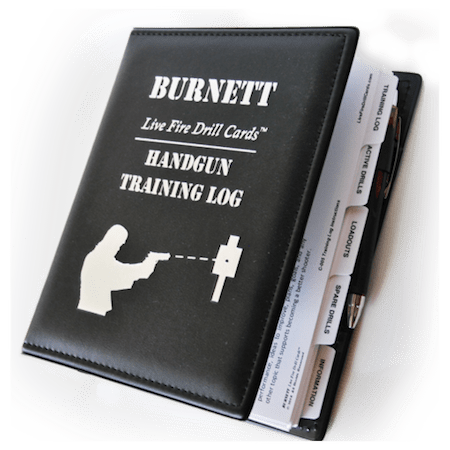Live Fire Drill Cards™
and Handgun Training Log
By Steve Barnett
Suggested retail $59.95 at https://livefiredrillcards.com
Reviewed by Gila Hayes
Several months ago, Network member Steve Burnett generously shared several prototype copies of a practice aid he was developing, a binder entitled Live Fire Drill Cards™ and Handgun Training Log. The product was so nice that I readily accepted his invitation to use what he had developed and if his Drill Cards proved useful, tell our fellow Network members about them. Since then, he has made several upgrades, resulting in a very nice three-ring binder stuffed to the gills with shooting drills focused on honing the various aspects of handgun accuracy. Despite the variety of exercises he has gathered in the Drill Cards binder, he continuously returns the user’s focus to accuracy throughout his work.
Steve told me, “I have invented a product to help people become better shooters. I did this to help myself but then it just got a life of its own and I realized I wasn’t the only person who could benefit.” His Live Fire Drill Cards™ and Handgun Training Log comes in a nicely outfitted three ring binder measuring 9” x 7” to fit in most range bags. It is filled with stiff tabs separating a permanent training log, check lists of equipment needed in practice sessions, plus a wealth of shooting drills and skill-building exercises on two-sided cards with space to record the user’s scores or results.
On the front of each drill card, Burnett listed the equipment needed, target type, information about whether it is suitable for practice at an indoor range, and he even squeezes in lines on which to record details like whether you did the exercise using your standard two-handed grip, one-handed strong hand or one-handed weak hand or with both hands, but fired weak-handed, for example. These details, like the scoring instructions, vary from drill to drill, with the result of creating many more variations than just the 30 drills provided on the cards. In addition, a small box at the drill card’s upper right identifies the skills focus of the exercise.
On the back of each drill card is the description of the stages of fire (most are more complex than a single stage), distances, how to run the drill, par time, and in some cases how to adapt the original for easy use at indoor ranges. Small type at the bottom of the page credits the instructor, expert or other source from which the exercise is derived, and the credits list is very diverse. The drill’s stage details are diagramed on the back of the card.
Each card includes a chart on which to record progress and skill development. Understanding that frugal shooters might balk at marking up the cards, Steve has packaged replacement cards with the drill cards priced at five replacements for $2.45 and the training log cards at 25 for $4.95. He even offers free downloads of the targets used in the drills on his website, although the targets can be purchased there, too.
I shared the Drill Cards around the office, with a sneaky plan to turn the binders into group practice session fodder, for which they serve admirably. Now, instead of showing up at the range with your friends and blowing a couple of hours burning up ammo and chatting, an orderly progression through the drill cards or a random draw gives focus and purpose to the session. Steve’s handy binder not only includes permanent records, but it is so much more durable and easier to use than the tattered envelope stuffed with drills and qualification tests I’ve harvested from various instructors over the years and carried in my range bag. That Burnett is more organized than I can ever aspire to be goes without saying!
We are greatly enjoying our copies of the Live Fire Drill Cards™ and Handgun Training Log. The investment in this system is $59.95 for the initial set, and as noted, affordable refill sets are available. Learn more about Steve and order the cards and binder he’s developed at https://livefiredrillcards.com/about/.
To read more of this month's journal, please click here.
